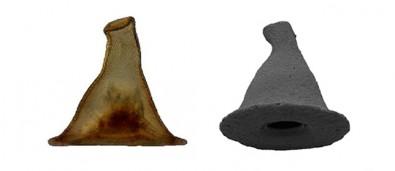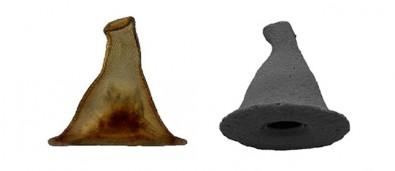
Credit: images: Jordana C. Féres & Alfredo L. Porfírio Sousa
Thecamoebians are among the 30-45 lineages of amoebae known to exist worldwide. During their evolution, they have developed the ability to produce a varyingly shaped outer carapace or shell in which to protect themselves.
A group of researchers at the University of São Paulo's Bioscience Institute (IB-USP) in Brazil, in collaboration with colleagues at the University of Maringá (UEM) in Paraná State, as well as a firm of environmental consultants based in Vila Velha, Espírito Santo State, and a researcher from Minas Gerais, have identified a species of thecamoeba with a carapace that resembles the wizard's hat worn by Gandalf, one of the most important characters in The Lord of the Rings, a series of novels by J.R.R. Tolkien (1892-1973).
Named Arcella gandalfi as a tribute to Tolkien's wizard, the new species of amoeba is described in an article published by the journal Acta Protozoologica.
"New amoeba species are very rarely discovered because they're so tiny and not widely studied. In addition, there are very few taxonomists who specialize in this group in Brazil," said Daniel J. G. Lahr, a professor in IB-USP's Zoology Department and the principal investigator for the project.
In recent years, Lahr began receiving reports of the existence of this species of freshwater microorganism from various parts of Brazil, such as Minas Gerais, Tocantins, Paraná, Amapá and Rio de Janeiro.
The number of specimens collected in these regions was so small, however, that it was impossible to perform a laboratory analysis to make sure that they genuinely represented a new species.
Last year, Lahr was contacted by Jordana de Carvalho e Féres, a biologist who works for a firm of environmental consultants in Espírito Santo. She specializes in taxonomic identification and population analysis of zooplankton, tiny invertebrates that float freely throughout the seas and other bodies of water. She had found the testate (shelled) amoeba in two samples collected from Amapá and Rio de Janeiro, she told him. The sample from Rio de Janeiro contained 180 specimens.
They agreed that she would go to Lahr's lab in São Paulo to train in microscopy techniques and partner with the group of researchers at IB-USP on a description of the new species.
"We succeeded in isolating the organism from the samples, performed all the necessary measurements and produced images to make sure it really was a new species," Lahr said.
Their analysis was based on biometric and morphological characterization. They concluded that the characteristic funnel shape of A. gandalfi was unique among species belonging to the genus Arcella, one of the largest genera of testate amoebae.
The color of A. gandalfi ranges from light yellow to brown, and the diameter and height of its conical shell average 81 and 71 micrometers, respectively. A micrometer is one-tenth of a millimeter.
Although A. gandalfi is microscopic, it is considered large for a single-celled organism. "It's just one cell, and yet it's capable of building this funnel-shaped carapace," Lahr said.
Because it is easily identified based on its morphological features and because its geographic distribution appears to be confined to South America, the researchers suggest its use as a new flagship species.
A flagship species is a key species for a specific ecosystem or habitat, and it can serve as an icon or emblem of an environmental cause.
According to Lahr, there are no records of any species resembling A. gandalfi from any other part of the world. "The identification of a new species of microorganism in the Southern Hemisphere, as in the case of this amoeba, is very strong evidence that its geographic distribution is restricted to the region because Northern Hemisphere environments have been studied in far more depth," he said. "This is especially so for such a conspicuous species with a shape unlike any other."
Most amoebae in the genus Arcella are less than half the size of A. gandalfi and vary considerably in morphology, typically being hemispherical or disk-shaped.
Some resemble an Asian rice hat, while others are crown-like with denticulations – small ridges resembling bristles or spines around the edges.
The genus Arcella comprises some 200 species and is one of the most diverse genera among thecamoebians.
Why the carapace?
The researchers do not yet know the exact purpose of the amoeba's carapace.
The classic idea is that the shell-like structure, made of silicon or organic matter secreted by the cell, serves as some form of protection against predators.
Lahr does not find this idea very plausible. "Thecamoebians are strongly predated, and we often find their carapaces ingested by a class of protozoans called ciliates, for example," he said. "For these microorganisms, the shell is not protective like armor plating, as it is in the case of arthropods, which are preyed on by animals of the same size."
One of the researchers' hypotheses is that the carapace may protect the amoebae not against predators but against dryness: abundant among plankton inhabiting shallow lakes and ponds, streams and reservoirs, as well as among aquatic plants, these amoebae are frequently left high and dry as water levels fluctuate.
"We think they're able to maintain a humid microenvironment inside the shell when it's dry outside, by storing even a tiny amount of water," Lahr said.
Another hypothesis is that the carapace affords protection against ultraviolet radiation. "Their habitats are aquatic, and they're often exposed to sunlight, so protection against UV rays must be a very important factor," he said.
"A multicellular organism has a number of protective barriers against UV radiation, including a layer of keratin, as well as skin pigments. In the case of single-cell organisms like amoebae, their DNA is basically exposed."
###
Media Contact
Samuel Antenor
[email protected]
55-113-838-4381
@AgencyFAPESP
http://www.fapesp.br





